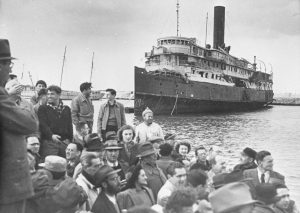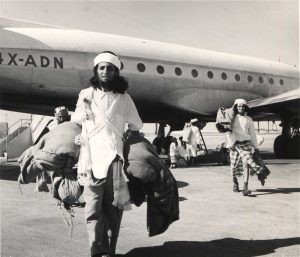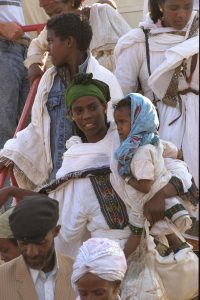Immigration to Israel has always been both: the wish to build and live in a homestead for the Jewish people in their ancient land, and a consequence of suppression, persecution and danger to life and limb in the land of one’s birth.
We tell a story of hope, of spectacular actions and the day-to-day efforts to make integration work, ensuring the “right to a life in dignity and freedom”…

Public Domain
A joke from the 1930s: “An immigrant arrives at the port of Haifa at the Yishuv, pre-state Israel. Having just set foot on the soil of the Promised Land, he is instantly asked: ‘Have you come here because of Zionism – or because of Hitler?’”
The anecdote shows that immigration to Israel has always been both: the wish to build and live in a homestead for the Jewish people in their ancient land, and a consequence of suppression, persecution, and danger to life and limb in the land of one’s birth.
Theodor Herzl, father of Zionism, penned his pamphlet The Jewish State (1896) under the impact of anti-Semitic rage he had experienced in France during the trial of Captain Dreyfus. According to Herzl, Jews should be able, if they so wished, to return to their historic homeland: “We shall live at last as free men on our own soil and die peacefully in our own homes.”
But even before Herzl formulated his dream, there was immigration to the Land of Israel. “Whosoever there is among you of all His people, his God be with him, – let him go up,” states the Book of Ezra. Moving to the Promised Land is making Aliyah, literally meaning “to go up.”
From the 1880s to the 1920s, during the first, second, and third Aliyot, more than 100,000 Jews came from Russia and Eastern Europe to their biblical homeland. The reasons for their immigration were manifold: Some wanted to live a religious life in the Land of the Fathers, and some were pioneers or adventurers. Others wanted to make their dream of a just and socialist society come true on the shores of the Mediterranean, and others were fleeing pogroms, violence, and hatred. The 1920s and 1930s saw an influx of Jews from Poland and the Soviet Union, where an increase in anti-Semitic policies was making life hard for them. The fifth Aliyah brought immigrants mainly from Germany in the 1930s as the Nazis were tightening their grip on the country, setting out on their path of annihilation by robbing the Jews of their civil rights.
During the “secret” Aliyah Bet between 1939 and 1945, more than 100,000 refugees entered Palestine. Their immigration was deemed “illegal” by the British, who at the time ruled over Palestine. Frequently, ships carrying refugees were intercepted by the British Navy and passengers were brought into detention camps. The most famous of these ships was the “Exodus”; the film based on the book by Leon Uris would later move millions to tears.

Operation Magic Carpet, 1949/50
(c) National Photo Collection / Public Domain
From the end of the Shoah until the founding of the state, some 100,000 survivors made their way to Palestine, still under British rule. Caring for these deeply traumatized people was, again, a colossal task.
Consequently, between the late 1880s and 1948, the Jewish population in Palestine had grown from 50,000 to 650,000 people. On May 14, 1948, the State of Israel was founded: “The catastrophe which recently befell the Jewish people – the massacre of millions of Jews in Europe – was another clear demonstration of the urgency of solving the problem of its homelessness by re-establishing in Eretz-Israel the Jewish State, which would open the gates of the homeland wide to every Jew and confer upon the Jewish people the status of a fully privileged member of the community of nations,” stated the Declaration of the Establishment of the State of Israel.
As soon as Israel had been established, Jews who for centuries had been living in countries like Iraq, Algeria, Egypt, Libya, were threatened, persecuted, and killed. Once flourishing communities were destroyed. The “gates of the homeland” were open for them: Around 800,000 Jews from these countries came to Israel. The enormous problems this influx of people posed for the young state were mastered in an exemplary manner and the Olim, those who had just made Aliyah, were integrated and helped build the state. Simultaneously, around half a million Holocaust survivors, mostly from Displaced Persons camps in Europe, arrived in Zion.
Never shy of spectacular action when desperately needed, Israel – still in its infancy – flew 49,000 Jews from Yemen to Zion during Operation Magic Carpet between 1949 and 1950. Having to leave the few possessions they had behind, they needed to make a new life in Israel. Similarly, in 1984 and 1985, the no-less spectacular Operation Moses brought some 8,000 Ethiopian Jews, known as Beta Israel, to Israel. And on May 24 and 25, 1991, Operation Solomon took place: 35 Israeli aircraft brought more than 14,000 Ethiopian Jews to Israel. During the operation, a trusty ElAl 747 made it into the annals of aviation history by carrying more than 1,100 passengers to freedom – the plane is constructed for about 600 passengers.

Nechama Rivlin, wife of Israel’s president, with soldiers
Tomer Reichman () / GPO Israel (CC BY-SA 3.0) https://creativecommons.org/licenses/by-sa/3.0/deed.en
In the meantime, with the decline and eventual collapse of the Soviet Union from the late 1980s onward, more than 1.6 million Jews set out with Israel as their destination. This exodus would have been a unique opportunity for Germany and its Jewry, overaged and declining at the time, to renew itself. But the German government decided only to take in 250,000 Russian emigrants.
Welcoming more
Many Russian Jews who made Israel their new home were well-educated and talented. Engineers, medical doctors, and artists helped advance Israeli society. A large number of them became indispensable for Israel’s growing IT-sector.
Anti-Semitic incidents in France made the number of French Olim grow rapidly over the past several years. About 40,000 French Jews have decided to turn their backs on La Douce France and make Israel their new home. It remains to be seen whether President Macron’s announcement, that France would not be the same without its Jewish people, will persuade French Jews to stay there.

Operation Solomon, 1991
Government Press Office (Israel) / https://creativecommons.org/licenses/by-sa/3.0/deed.en
In recent years, another form of immigration has become an integral part of Israeli society, even if it is not overseen by the Jewish Agency. This includes the hosts of people who come to Israel to work and help ensure a smooth day-to-day running of things: Thai women and men working in agriculture, Romanians on building sites, and Filipinos, who have become vital in ensuring that elderly Israelis are well cared for.
Over the last decade, some 40,000 immigrants from Africa have entered Israel illegally. Government attempts to enforce a return to their home countries were thwarted due to public protest and the subsequent decision made by the High Court in Jerusalem.
Israel continues to welcome immigration and ensure that its Olim quickly find their place in their new society. Sure, the integration of a vast number of immigrants in this tiny country has not always been smooth sailing, and the different groups might bear grudges against one other every now and then, as brothers and sisters sometimes do. But they are all united when it comes to standing up for Israel, which ensures their “right to a life in dignity and freedom.”■
